Email Question
Dear Gail, I loved your new video on exercises for optimal fetal positioning! I finally got my second baby into the right position but alas, he did not engage and I did not go into labour which resulted in an elective section at 42 weeks. I had a previous cesarean when my waters broke without contractions. My first baby didn’t engage despite being induced. I’m now wondering if there is something wrong with my hips? Do you have any idea on why neither of my babies engaged?
Please note: Slight editorial changes were made here to help you understand the email better.
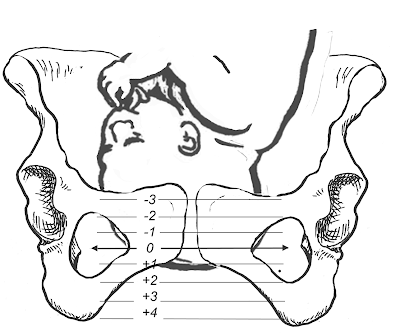
This baby is well engaged and fitting through the inlet and midpelvis.

Lack of engagement in the pelvic brim (inlet). One parietal eminence remains outside the pelvic brim.
Baby stays high, -3 Station or higher.
From Smellie.
Gail’s Response
Congratulations on new motherhood again. Congratulations on your new baby! I’m so impressed with how much you did to achieve a natural birth and try to wait for labor. I may be able to shed some light on the mystery or, I may not…let’s try.
When baby is in an optimal position and doesn’t engage I wonder about
- Misalignment of the pelvis (SI and symphysis joints, rotation of sacrum on vertical axis)
- A reduced diameter of the pelvic inlet from nutritional or sunlight deficiencies growing up
- Psoas tightness (see www.coreawareness.com)
- Scoliosis
- Something to do with the baby and cord: short or wrapped cord, or baby’s arm in the way
- Dates are incorrect and baby is 2-4 weeks early
- An overall small pelvis. When an ideally positioned baby, Flexed and Left Occiput Anterior or Left Occiput Transverse doesn’t fit the bones, then we have a true Cephalo Pelvic Disporportion, or CPD, which means baby’s head really is too big for the pelvis.
To guide our train of thought, I want to acknowledge that you’ve had two babies that did not engage. That makes the question of correct dates, a short or wrapped cord, or compound presentation (hand or arm coming with the head) unlikely.
My questions to help detect some more clues:
Do you know of any spinal or pelvic misalignments or differences to the average in your situation?
Did either baby have any molding on the head? Molding would typically only be seen after many hours of very strong and frequent uterine contractions. Actually, many babies that haven’t engaged even with strong, frequent contractions show no molding of the head. But its a clue that may help if it is present.
Sometimes if a woman’s outlet is quite wide, the inlet is narrowed, by a torque that closes the brim and opens the outlet. Think of a clothes pin and as you open the clothes pin the top of the sticks get closer together. This can be corrected if it is the case. A spasm in the ligaments is the cause. The right kind of body work is necessary.
How would you know if you have a wide outlet?
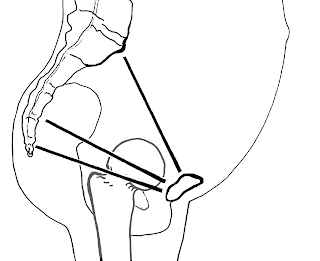
The lines represent (from the top) the pelvic inlet, the midpelvis, and the outlet diameters.
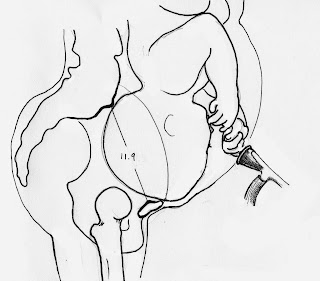
A posterior baby remains on the pubic bone and not engaged.
Doing your own Pelvimetry to figure out if pelvic shape is a contributor.
Pelvimetry means measuring the pelvis. We can do a simple approach to get a general idea of pelvic shape. The following is a just for fun self test. The test is not detailed enough to be definitive. See an experienced midwife, obstetrician, or labor and delivery nurse for verification of your pelvic size and shape. MRI measurements may help, but really, labor decides if the pelvis is big enough.
Let’s talk about three places in the pelvis for a self-check.
- The sitz bones
- The pubic arch
- The front to back distance between bones (not the padding around the bones, so to speak)
- The side to side distance between hip bones.
Remember, Measurements can’t usually tell you if you can fit a baby through the pelvis. Once the baby is engaged, then the size of the pelvis becomes less important than the mobility of the pelvis!!
I include this because many women ask, not because I think that the answers tell whether or not you can have a baby through your pelvis. This is a guide, a beginning. The land is not the journey, however. Let’s start the self test.
Lie down, wearing thin stretch pants or undies to do these first two checks. Stand for the last check.
1. ) The Sitz bones, or Ischial Tuberosities, make up the side limits of the outlet.
If the outlet is pulled wide by ligaments and chronic muscle tension (you don’t have to feel tense emotionally for this to have happened over the years), it may be that the inlet is pulled narrow.
To find out see if your own fist fits easily between your sitz bones (externally!).
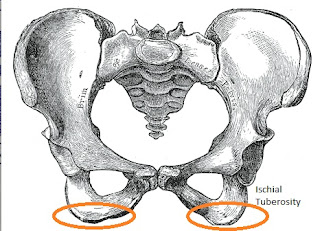
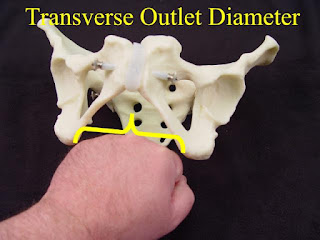
Image from https://library.jefferson.edu/Collections/DVDs/obgyn101/Text/Abnormal%20L&D/fetopelvic_disproportion.htm
You can lay on your side and use your own fist from behind you. Or, ask your mate.
Find your top sitz bone beneath the padding of the upper buttocks.
Feel for the edge of the lower sitz bones, its a bit of a reach.
Closing your hand, place your fist between the tuberosities and choose the best description:
A. You can feel both sitz bones at once on the edges of your fist, or a slight tilt brings you in touch with the second sitz bone.
B. You can easily feel space around your fist in addition before your sitz bones are touched by your fist. Roomy.
Now,
2.) Feel for your pubic arch.
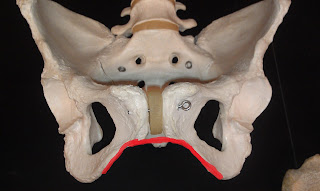
Pubic arch in red
Laying on your back with knees bent, wrap your fingers around your pubic arch. It’s like a kid grabbing themselves to avoid peeing their pants. You don’t have to smash your fingers into your urethra, be kind. The measuring place is between the top and the sitz bones at the bottom of the pubic arch.
A. Is there room for three fingers or 1 and a bit more?
B. Or is the arch very wide, even four of your own fingers fit across?
This second check verifies the first check.
Now stand,
3. ) Approximate the depth of your inlet.
Have a helper measure the visual distance between your pubic bone and top of your sacrum.
They kneel next to you and by just eyeing the distance, not wrapping the measuring tape,
they hold one end to the front and one end horizontally to the back. This is very simplistic.
A. My distance is about 9 inches
B. My distance is about 7 inches
This is a rather subjective measurement. If you have a girlfriend about your size, you can measure each other and compare.
By far, most people measure 9 inches or a little more. Remember, you aren’t measuring fat or clothes, find the bones and approximate. A measurement of about 7 inches, more or less, might mean the front to back distance is a short distance. See more in pelvic shape.
An alternate way of assessing if one has a Platypelloid Pelvis
4.) Approximate distance between hips
Stand and measure the distance from hip to hip (ASIS). Use a tape measure or ruler.
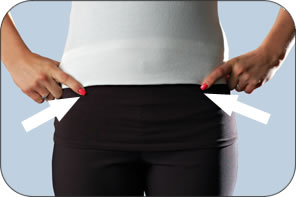
Image from https://www.activeortho.com/store/how_to_measure_si_belt.html
I also like the Serola Sacroiliac belt https://www.serola.net/serola-sacroiliac-belt
Your hip to hip bone measurement is
A. 11-13 inches
B. 15-17 inches between boney hips.
The fourth measurement verifies the 3rd.
Outcomes of Your Pelvimetry
If you answer B to these questions, you are likely to have a small inlet.
If you answer A to these questions, you might still have a small inlet or not, its not conclusive.
You can also ask an experienced (years and years of) midwife or Labor and Delivery Nurse to do your pelvimetry for you. But they will not necessary know that an extra wide outlet may mean an extra constricted inlet. We can’t feel the inlet for one thing.
Not many birth care providers understand how one change in a pelvis causes another. They would think wide outlet means a big inlet, too. This would make some people shrug or say its not a pelvic issue.
And of course, sometimes that is correct, when the overall pelvis is large. That’s not our assumption for this situation. We may be seeking clues here for pelvic torsion, I believe, or cephalo pelvic disproportion. Let’s rule out Pelvic Shape first.
Pelvic Shape and Engagement
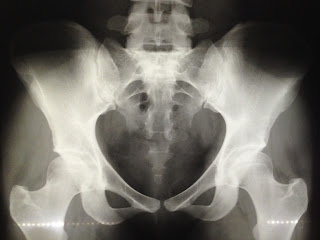
Another possibility to lack of engagement is an triangular shaped pelvis, called the Android pelvis, which can make engagement an issue.
In that case, you find close tuberosities (Sitz bones) and a very narrow pubic arch of only 1.5 or maybe 2 fingers across.
Not engaging from a posterior position is common for this pelvic shape. Helping baby be in an ideal LOA position usually brings about engagement and labor progress. It is not uncommon for birth providers not to know how to help engage baby in an android pelvis. Walking the halls is unlikely to engage or rotate a posterior baby in this pelvis.
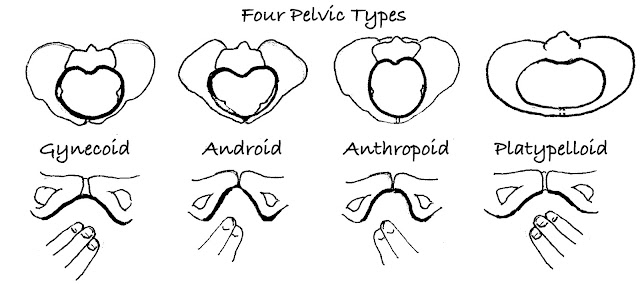
Another possibility to lack of engagement is a narrow front-to-back pelvic diameter, called the Platypelloid pelvis, which can make engagement an agony when baby starts posterior. Helping this baby into a Left Occiput Transverse position is the only way for baby to engage. That will immediately relieve the brim pain and labor will likely stop so the uterus can rest and then after a meal, labor will resume and bring the baby in 6-8 hours. If the uterus doesn’t need a rest (maybe because baby started LOT then labor may be 24 hours or less in this pelvis, a second baby may come in 6-8 hours total if starting LOT.)
When pelvic shape is the issue, we see that skills in supporting a labor with a pelvis that is not round is of key importance. Skills to support labor are slipping away from the world. Spinning Babies is determined to bring them back!
And
I hope some of this is helpful. Most of what you read here will not be useful to you, so I include this hoping that you find some clue to help you decide what to do for a future pregnancy or put a new story for your past experience.
Finding a way to make sense of something unexpected that didn’t fit our expectations is really a first and major step in healing.
Soon, I heard back:
“This is amazing! Thank you Gail!!
I’m so thankful for your response as the midwives and doctors I have asked have not been helpful.
Yes, you can absolutely use my question in your blog. My first baby was [Occiput Posterior] which is why I believe the waters broke early – well it was actually on my due date but I always presumed he just wasn’t ready to come but if it is a case of there being something wrong with my hips then it could be that he just couldn’t engage…
My mother was told she had “tilted hips” which resulted in 3 c-sections for here so perhaps there is hereditary here!
I had been preparing for a VBAC for over a year! I never thought I’d end up with an elective but just bring supported by the hospital staff to go right up to 40+16 was healing for me, I felt like I gave it my best shot but I am just so curious as to why I didn’t go into labour!… “
Gail ponders,
Well, now we have another clue. I wonder what “tilted hips” means? Could simply be a steep inlet which often needs a vertical position, like standing up and leaning forward, to help baby engage. It could also mean the hips are rotated in such a way that the baby needed mother to add body balancing to help baby find the space to enter the pelvis.
“Let’s make room for the baby” is not imploring a magical increase in hip size! It means aligning the hip joints and so the muscles within the hips. It means lengthening and releasing muscles and ligaments to help the pelvic bones be more aligned and more mobile -just as nature intended!
A chiropractor or osteopath has skills for pelvic alignment. And some have the extra training for myofascial release of pregnant women, such as taught by Dr. Carol Phillips, DC, in Annapolis, Maryland (www.dynamicbodybalancing.com). Explore the possibilities of professional help.
Why a baby didn’t engage is a common question.
We have some techniques that may help reduce the higher percentage of babies born by cesarean when they are unable to engage in labor, but we may not be able to help every mother and baby with engagement. Next blog, Engaging Baby in Labor. See the references there.



 The lines represent (from the top) the pelvic inlet, the midpelvis, and the outlet diameters.
The lines represent (from the top) the pelvic inlet, the midpelvis, and the outlet diameters. A posterior baby remains on the pubic bone and not engaged.
A posterior baby remains on the pubic bone and not engaged.
 Image from https://library.jefferson.edu/Collections/DVDs/obgyn101/Text/Abnormal%20L&D/fetopelvic_disproportion.htm
Image from https://library.jefferson.edu/Collections/DVDs/obgyn101/Text/Abnormal%20L&D/fetopelvic_disproportion.htm

